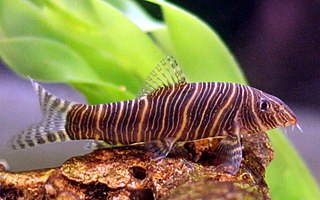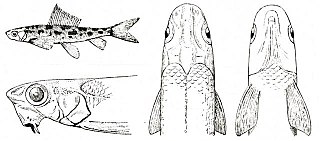
Cypriniformes is an order of ray-finned fish, which includes many families and genera of cyprinid fish, such as barbs, gobies, loaches, botias, and minnows. Cypriniformes is an "order-within-an-order", placed under the superorder Ostariophysi—which is also made up of cyprinid, ostariophysin fishes. The order contains 11–12 families, over 400 genera, and more than 4,250 named species; new species are regularly described, and new genera are recognized frequently. Cyprinids are most diverse in South and Southeast Asia, but are entirely absent from Australia and South America. At 112 years old, the longest-lived cypriniform fish documented is the bigmouth buffalo.

Cobitidae, also known as the true loaches, is a family of Old World freshwater fish. They occur throughout Eurasia and in Morocco, and inhabit riverine ecosystems. Today, most "loaches" are placed in other families. The family includes about 260 described species. New species are being described regularly.

Balitoridae, the hillstream loaches or river loaches, is a family, of small fish from South, Southeast and East Asia. The family includes about 202 species. They are sometimes sold as "lizardfish" or "flossensaugers". Many of the species are popular for aquaria, species in the genus Sewellia are most commonly sold in the aquaria trade. They have a number of similarities with the Cobitidae, their sibling family of "loaches", such as multiple barbels around the mouth. They should not be confused with the loricariids, which look similar but are a family of catfish.

The clown loach, or tiger botia, is a tropical freshwater fish belonging to the botiid loach family. It is the sole member of the genus Chromobotia. It originates in inland waters in Indonesia on the islands of Sumatra and Borneo. In Sentarum, West Borneo that fish named: ulanguli. It is a popular fish in the freshwater aquarium trade and is sold worldwide.

Botia is a genus of freshwater fish in the loach family (Botiidae). It was a large genus with about 20 species. In 2004 Maurice Kottelat proposed in his paper to divide the genus into four related genera based on fish appearance and locality:
Maurice Kottelat is a Swiss ichthyologist specializing in Eurasian freshwater fishes.

Pharyngeal teeth are teeth in the pharyngeal arch of the throat of cyprinids, suckers, and a number of other fish species otherwise lacking teeth.
The true Kuhli loach, which can be used synonymously with "coolie" loach, occasionally referred to as eel loach, is a small eel-like freshwater fish belonging to the loach family (Cobitidae). They originate from the island of Java in Indonesia. This serpentine, worm-shaped creature is very slender and nocturnal. Its distinctive orange-pink coloration with triangular black stripes and long lifespan makes it a popular aquarium species.

Loaches are ray-finned fish of the suborder Cobitoidei. They are freshwater, benthic (bottom-dwelling) fish found in rivers and creeks throughout Eurasia and northern Africa. Loaches are among the most diverse groups of fish; the 1249 known species of Cobitoidei comprise about 107 genera divided among 9 families.

Bhavania is a genus of freshwater ray-finned fishes belonging to the family Balitoridae, the loaches in this family are commonly known as hillstream loaches although this name also refers to the loaches in the family Gastromyzontidae. The loaches in this genus are foiund in southern India.

Ellopostoma is a small genus of loaches native to Southeast Asia. This is the only genus in the family Ellopostomatidae, having been confirmed as being in a family of its own by M. Kottelat in his review of the loaches in 2012.

Hypergastromyzon is a genus of ray-finned fish belonging to the family Gastromyzontidae, commonly called the hillstream loaches, although this also refers to the loaches in the family Balitoridae. The loaches in this genus are endemic to the island of Borneo in Southeast Asia.

Jinshaia is a genus of freshwater ray-finned fishes belonging to the family Balitoridae, the loaches in this family are commonly known as hillstream loaches although this name also refers to the loaches in the family Gastromyzontidae. These loaches are endemic to China.
Metahomaloptera is a genus of freshwater ray-finned fishes belonging to the family Balitoridae, the loaches in this family are commonly known as hillstream loaches although this name also refers to the loaches in the family Gastromyzontidae. These loaches are endemic to China.
Protomyzon is a genus of ray-finned fish belonging to the family Gastromyzontidae, commonly called the hillstream loaches, although this also refers to the loaches in the family Balitoridae. The loaches in this genus are endemic to Borneo.

Vaillantella, the long-fin loaches, is a small genus of loaches found in Southeast Asia. This genus is the only member of the family Vaillantellidae having been confirmed as such by M. Kottelat in his review of the loaches in 2012.

Serpenticobitis, popularly known as serpent loaches, is a small genus of loaches found in the Mekong River Basin in Southeast Asia. It is the only genus in the family Serpenticobitidae.

Balitoropsis also known as the lizard loaches is a genus of freshwater ray-finned fishes belonging to the family Balitoridae, the loaches in this family are commonly known as hillstream loaches although this name also refers to the loaches in the family Gastromyzontidae. These loaches are found in mainland Southeast Asia, Sumatra and Borneo.

Homalopteroides is a genus of freshwater ray-finned fishes belonging to the family Balitoridae, the loaches in this family are commonly known as hillstream loaches although this name also refers to the loaches in the family Gastromyzontidae. These loaches are found in Southeast Asia.

Homalopterula is a genus of freshwater ray-finned fishes belonging to the family Balitoridae, the loaches in this family are commonly known as hillstream loaches although this name also refers to the loaches in the family Gastromyzontidae. These loaches are found only in Sumatra in Indonesia.















